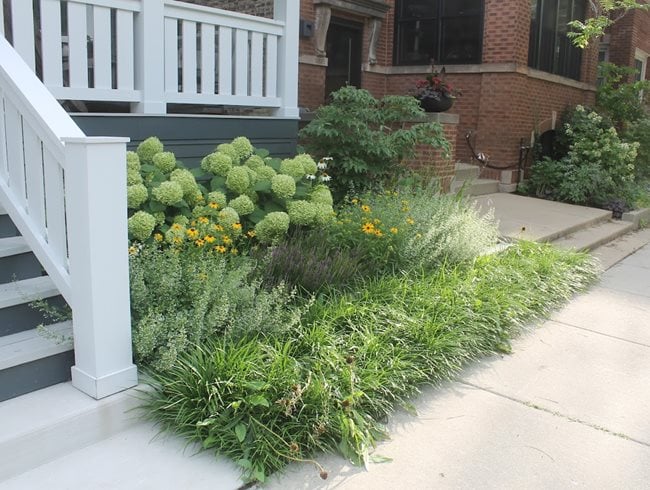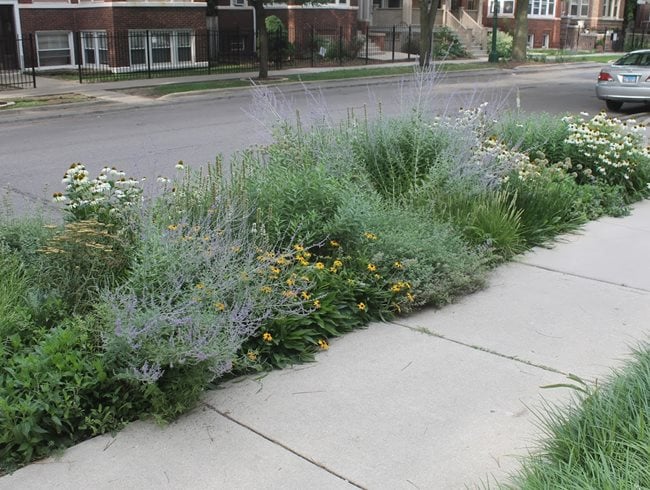SIDEWALK GARDEN: A PERENNIAL PARKWAY IN CHICAGO
A tiny front yard and parkway garden reflect the warmth and friendliness of its residents.PROJECT:
The renovation of an Arts and Crafts four-square in the Albany Park neighborhood of Chicago.
SUBMITTED BY:
Megan Wade, Fieldwork Design Group
On a lot where the house is set back only 8’ from the property line, the front yard and parkway became a staging area for construction materials for two years. When it was finally uncovered, we found a plantless plot of land desperately in need of a new vision.
See below for Megan's tips on what to consider when planting a sidewalk garden.

As two long-time Chicago residents and design professionals, it was important that the front porch design captured the spirit of the architectural style of the home. My husband and architect, David Schroeder, wanted to respect the stateliness of the home and revel in details more appropriate to the style than the previous porch had exhibited. For the garden, my intent was to create a foil to the formality of the home so that the overall feeling reflected the warmth and friendliness of our small family.

Both the front yard garden and parkway are purposefully colorful and quite wild, contrasting with the square and solemn architecture. As a landscape architect, I could not resist the opportunity to extend the garden out into the parkway. The front yard is rather small, after all. It was a chance to showcase my skills, try out new plant combinations, and watch it change over the season in a way that I can never watch a client’s garden. (I would be accused of stalking!)

The front yard was conceived as a traditional, cultivated garden. It contains drifts of plants one might find in an old-fashioned American garden—Hydrangea arborescens ‘Annabelle’, boxwood (Buxus ‘Glencoe’), black-eyed Susan (Rudbeckia fulgida), catmint (Calamintha nepeta ssp. nepeta), and Veronica ‘Wizard of Ahhs’. A Cornus kousa anchors the corner of the bed, and a thin linear bed of Liriope spicata lines the public walk.

As the Garden extends into the parkway, the palette becomes a bit wilder and the drifts are smaller and mixed, evoking the sense of a stylized native landscape. Color and form are repeated to give the plantings a sense of rhythm and intentionality and to tie the two areas together. Friendly yellows, oranges, and whites contrast nicely with the dark gray of the house. Blue accents balance out warmer tones.

The plant palette for both gardens was planned to ensure visual interest throughout the seasons. In early summer, 'Walker's Low' catmint and bluestar bloom with their greens contrasting with the brightness of autumn moor grass. May Night sage shortly follows, with Achillea ‘Walter Funcke’ coming in as the salvia fades. Then, liatris and white coneflower appear with Russian sage carrying on the blue hues. Hydrangea and black-eyed Susan round out the fall. We will leave all the perennials uncut for the winter for the birds to feast on—a field of browns has its own beauty. In fall, we will add bulbs to the garden as well for spring interest.
WHY PLANT A SIDEWALK GARDEN?
In many neighborhoods in Chicago, homes sit rather close to the front property line, which means that the front yard is very small or non-existent. The parkway (the strip of greenery between the public sidewalk and the street) is maintained by the residents, but it is technically owned by the city. In certain circumstances, lawn is an appropriate choice—it is at least green and it can be walked on, which is helpful where most people park at the side of the street.
We chose to plant perennials instead of lawn for various reasons. A prime motivator was a desire to eliminate lawn maintenance. While perennial gardens do require maintenance, this parkway garden requires less maintenance from week-to-week than lawn. And of course, it is much more visually interesting. It draws us outside to see how it has changed from day to day, week to week.
In addition, mixed perennial beds offer ecological benefits such as providing food and habitat for pollinators and wildlife. This garden requires no pesticides or fertilizers to thrive, and the plants were selected for their durability and drought tolerance.
One unanticipated benefit is that we’ve met so many of our neighbors when spending time gardening in the parkway. Interactions with passerbyers are much more likely without the whir of a lawn mower, weed whacker, or leaf blower. People stop to ask questions about names of certain plants or just to talk about the weather. It is a great conversation starter. Since we only moved in recently, this has been a wonderful bonus!
CONSIDERATIONS WHEN PLANTING A SIDEWALK GARDEN
Mind the rules.
Before undertaking any streetside planting projects, check your city's codes. Many municipalities have restrictions on what can and can't be planted there.
Plant in groups.
It is easier to see the underlying order of a garden when species are planted in groups. Scale your drifts of plants so that the garden is legible to those who pass by. In this parkway, species are generally in drifts of 5 plants for the lower plants, and in drifts of 3 plants for any of the spire-like plants.
Repeat color and form.
Repetition in color and form will give the garden a cohesive look, even with a wilder plant palette. Consider echoing colors or species that are present in your front yard to link the two spaces visually.
Plant densely.
Keep the spacing between the plants tight. There will be fewer weeds and people will be less inclined to cut through your planting.
Create definition.
For the edge plants, consider species with foliage that appears early in the season, like autumn moor grass, catmint, and Allium ‘Summer Beauty’. The early greens signal pedestrians that the area is a garden and deter people from walking through it. Select perennials that will still have a presence in winter for the same reason, especially if you experience snow.
Visibility.
Consider the end height of your plantings. While a few spires can add drama to a planting, maintaining visibility is important. Pedestrians will feel safer if they can see over the planting. Visibility at corners is especially critical. A good rule of thumb is to keep plantings at intersection corners to a height of 30” or less.
Allow room for car doors.
If there is street parking adjacent to your parkway, leave a 15” gap at the edge near the street so passengers can open their door and exit the car.Plan for watering.
While the garden is still becoming established, or in times of severe heat, you’ll need to run a hose across the walk. If you stick with drought-tolerant plants, you’ll have to do this less often. Consider purchasing a colorful sprinkler so that people will be able to spot it and avoid it if it has to be in the public way.
Join us for our next webinar!
From Plan to Planting: Designing a Garden for Every Season, with Rebecca Sweet
May 15, 2025
RELATED:
Front Yard Landscaping Ideas
Full-Sun Perennials
How to Create a Meadow Garden

